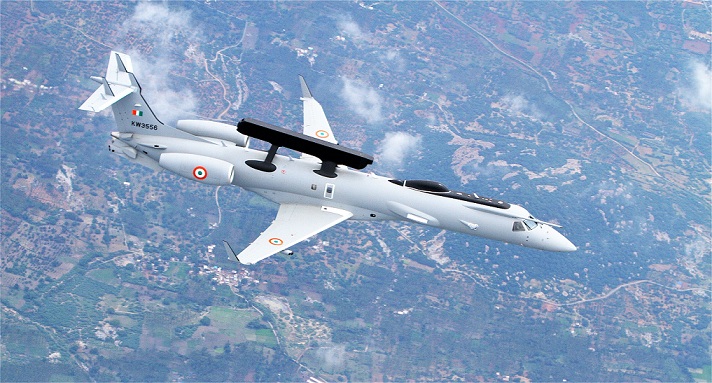Indigenous development of strategic defence systems and equipment is a long drawn process, beset with technological challenges and potential failures. This many a times attracts criticism of defence research in India. But some technologies are so critical that long delays and even accidents don’t deter scientists from pursuing them because such technologies are not available off-the-shelf. Air-borne early warning and control system or AWACS is one such strategic technology.
The Airborne Early Warning and Control (AEW&C) aircraft, developed by the Defence Research and Development Organisation (DRDO) along with the Indian Air Force (IAF), is a little known success in defence research. The system called Netra which was inducted into the armed forces in 2017 played a ‘behind the scene’ role in the much talked about Balkot surgical strikes in February 2019.
While it was reported that the mission was carried out by strike aircraft Mirage 2000 with a couple of Su-30MkI providing cover during the pre-dawn aerial attack and the retaliatory operation next day when F-16 combat jets of Pakistan Air Force attempted to violate the Indian airspace, it was the indigenous AEW&C which alerted MiG-21s and other fighters on air patrol about F-16s, resulting in a dog fight between the MiG-21 and F-16.
The air-borne early warning system consists of radars mounted on an aircraft along with all necessary controls and electronics, duly supported from the ground systems and data. Such a system has the ability to detect and track multiple airborne intruders simultaneously, and also identify if they are friend or foe. This enables forces on the ground and in the air to initiate counter-measures. The system can also intercept hostile communications and radar signals from the ground or air and determine their locations. The aircraft can remain in flight for long hours as it is equipped with in-flight refuelling facility.
The IAF currently has two indigenous AEW&C aircraft in its fleet, and has placed an order for three more with DRDO. Another system tailor-made for the Indian Navy and Coast Guard for maritime operations in being designed by the Bangalore-based Centre for Airborne Systems (CABS).
“India is only the fourth country in the world to have developed this advanced system, popularly known as the ‘Eye-in-the-sky’, for its ability to detect enemy aircraft soon after they are air borne with the help of a radar on-board the aircraft although it is akin to looking for a needle in a haystack. While patrolling the sky at a distance of 300 kilo meters from the border, it can alert air force bases to launch interception missions, and guide the IAF jets in the event of a dog fight,” explained Dr K Ramchand, founder director of CABS and a member of the development team, while speaking to India Science Wire.
Dr Ramchand, a former Wing Commander with IAF who later joined DRDO, has co-authored a book “The Incredible Journey of Indian AWACS” tracing the journey of the project since 1981 when the idea was first mooted. Other co-authors of the book are S Krishnaswamy, also a former member of the project team, and B R Srikanth, science journalist with Deccan Chronicle in Bangalore.
It began as Airborne Surveillance Programme with a modest budget and a new outfit called Aerospace Surveillance Warning and Control organisation (later named CABS) was formed in 1985, with Dr Ramchand as its chief executive officer. The project was initially named ‘Guardian’ but later changed to Airawat.
A number of DRDO labs were involved in the project. Two new Avro HS 748 aircraft from IAF were given to be fitted with rotodome, antenna, communications etc. Developing an appropriate rotodome was a major task as it involved detailed studies on load distribution, aerodynamics, performance etc. Initially only pylons were fitted and test flights were conducted. The first flight after fitting the rotodome was conducted in November 1989. Following development of antenna and other systems and their integration, the platform was ready in 1991.
After 220 sorties over land and along seacoast as well as demonstration flights during Aero India shows, the ASP suffered a setback in January 1999 when one of the two rotodomed aircraft crashed during its approach to INS Rajali near Chennai coast. The rotodome got separated in air and the aircraft crashed a short distance from the runway, killing four personnel each from IAF and DRDO.
The programme was revived in 2002 with the IAF and DRDO interacting constantly to roll out a more advanced system. EMB-145 regional transport jet capable of carrying 3000 kg payload was chosen for AEW&C system and orders were placed in 2008. The first Embrier with India-developed rotodome flew in June 2011, following which integration of mission systems was taken up. Tests flights and air-to-air refuelling tests followed soon.
The book is an interesting narrative of an incredible technology development project, with insights shared by scientists, engineers, and officers in uniform who battled against all odds to design and operate the system. It is filled with personal anecdotes about every facet of the project, high risks endured and decisions taken over three decades. (India Science Wire)


















Discussion about this post